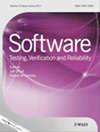Automatically identifying potential regressions in the layout of responsive web pages
IF 1.2
4区 计算机科学
Q3 COMPUTER SCIENCE, SOFTWARE ENGINEERING
引用次数: 11
Abstract
SUMMARY Providing a good user experience on the ever-increasing number and variety of devices being used to browse the web is a dif fi cult, yet critical, task. With responsive web design, front-end web developers design web pages so that they dynamically resize and rearrange content to best fi t the dimensions of a device ’ s screen. However, when making code modi fi cations to a responsive page, developers can easily introduce regressions from the correct layout that have detrimental effects at unpredictable screen sizes. For instance, the source code change that a developer makes to improve the layout at one screen size may obscure a page ’ s content at other sizes. Current approaches to testing are often insuf fi cient because they rely on limited tools and error-prone manual inspections of web pages. As such, many unintended regressions in web page layout often go undetected and ultimately manifest in production websites. To address the challenge of detecting regressions in responsive web pages, this paper presents an automated approach that extracts the responsive layout of two versions of a page and compares them, alerting developers to the differences in layout that they may wish to investigate further. We implemented the approach and empirically evaluated it on 15 real-world responsive web pages. Leveraging code mutations that a tool automatically injected into the pages as a systematic simulation of developer changes, the experiments show that the approach was highly effective. When compared with manual and automated baseline testing techniques, it detected 12.5% and 18.75% more injected changes, respectively. Along with identifying the best parameters for the method that extracts the responsive layout, the experiments show that the approach surpasses the baselines across changes that vary in their impact, but works particularly well for subtle, hard-to-detect mutants, showing the bene fi ts of automatically identifying regressions in web page layout. © 2020 John Wiley & Sons, Ltd.自动识别响应式网页布局中潜在的倒退
在越来越多、种类越来越多的设备上提供良好的用户体验是一项艰巨而又关键的任务。有了响应式网页设计,前端网页开发人员设计网页,以便他们动态调整和重新排列内容,以最适合设备屏幕的尺寸。然而,当对响应式页面进行代码修改时,开发人员很容易从正确的布局中引入回归,这对不可预测的屏幕尺寸有不利影响。例如,开发人员为改进一种屏幕尺寸的布局而对源代码进行的更改可能会使其他尺寸的页面内容变得模糊。目前的测试方法往往是不够的,因为它们依赖于有限的工具和容易出错的网页手工检查。因此,网页布局中许多意想不到的回归通常不会被发现,并最终在生产网站中表现出来。为了解决在响应式网页中检测回归的挑战,本文提出了一种自动化的方法,提取一个页面的两个版本的响应式布局,并对它们进行比较,提醒开发人员他们可能希望进一步研究的布局差异。我们实施了这种方法,并在15个真实的响应式网页上进行了实证评估。利用工具自动注入页面的代码突变作为开发人员更改的系统模拟,实验表明该方法非常有效。与手动和自动化基线测试技术相比,它分别检测到12.5%和18.75%的注入变化。除了确定提取响应式布局的方法的最佳参数外,实验表明该方法超越了影响变化的基线,但对于微妙的,难以检测的突变尤其有效,显示了自动识别网页布局回归的好处。©2020 John Wiley & Sons, Ltd
本文章由计算机程序翻译,如有差异,请以英文原文为准。
求助全文
约1分钟内获得全文
求助全文
来源期刊

Software Testing Verification & Reliability
工程技术-计算机:软件工程
CiteScore
3.70
自引率
0.00%
发文量
34
审稿时长
>12 weeks
期刊介绍:
The journal is the premier outlet for research results on the subjects of testing, verification and reliability. Readers will find useful research on issues pertaining to building better software and evaluating it.
The journal is unique in its emphasis on theoretical foundations and applications to real-world software development. The balance of theory, empirical work, and practical applications provide readers with better techniques for testing, verifying and improving the reliability of software.
The journal targets researchers, practitioners, educators and students that have a vested interest in results generated by high-quality testing, verification and reliability modeling and evaluation of software. Topics of special interest include, but are not limited to:
-New criteria for software testing and verification
-Application of existing software testing and verification techniques to new types of software, including web applications, web services, embedded software, aspect-oriented software, and software architectures
-Model based testing
-Formal verification techniques such as model-checking
-Comparison of testing and verification techniques
-Measurement of and metrics for testing, verification and reliability
-Industrial experience with cutting edge techniques
-Descriptions and evaluations of commercial and open-source software testing tools
-Reliability modeling, measurement and application
-Testing and verification of software security
-Automated test data generation
-Process issues and methods
-Non-functional testing
 求助内容:
求助内容: 应助结果提醒方式:
应助结果提醒方式:


